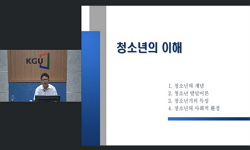가출청소년의 증가, 저연령화, 장기화 문제의 심각성이 대두되면서 정부 및 민간에서는 다양한 대응방안을 마련하여 왔다. 대표적으로 위기청소년을 위한 CYS-NET 이 있으며, 가출청소년을 ...
http://chineseinput.net/에서 pinyin(병음)방식으로 중국어를 변환할 수 있습니다.
변환된 중국어를 복사하여 사용하시면 됩니다.
- 中文 을 입력하시려면 zhongwen을 입력하시고 space를누르시면됩니다.
- 北京 을 입력하시려면 beijing을 입력하시고 space를 누르시면 됩니다.
장·단기 가출청소년의 개인 및 가족특성의 차이에 관한연구 = (A) study on sort and long term runaway youth's personal and family characteristic difference
한글로보기https://www.riss.kr/link?id=T12281349
- 저자
-
발행사항
부천 : 가톨릭대학교 사회복지대학원, 2011
-
학위논문사항
학위논문(석사) -- 가톨릭대학교 사회복지대학원 , 사회복지학과 , 2011. 2
-
발행연도
2011
-
작성언어
한국어
- 주제어
-
DDC
362.74 판사항(21)
-
발행국(도시)
경기도
-
형태사항
vii, 111 p. : 삽도 ; 26 cm
-
일반주기명
가톨릭대학교 (성심) 논문은 저작권에 의해 보호받습니다.
지도교수: 이상균
참고문헌(p. 83-91 ) 포함 - 소장기관
-
0
상세조회 -
0
다운로드
부가정보
국문 초록 (Abstract)
가출청소년의 증가, 저연령화, 장기화 문제의 심각성이 대두되면서 정부 및 민간에서는 다양한 대응방안을 마련하여 왔다. 대표적으로 위기청소년을 위한 CYS-NET 이 있으며, 가출청소년을 위한 특성화기관으로 청소년쉼터가 있다. 구체적으로 청소년쉼터에서는 2005년부터 가출청소년의 조기발견과 장기가출청소년에 대한 효과적인 개입을 위해 일시쉼터, 중장기쉼터를 운영하여 가출청소년에 대한 체계적 지원을 실시하고 있다.
실천현장에서의 이러한 대응은 위기청소년 중에서도 고위험군에 있는 가출청소년들을 위해서는 긍정적인 변화라고 볼 수 있지만 이러한 대응이 실증적이고 체계적인 연구자료에 기반하고 있지 못한 것이 현실이다. 특히 장기가출청소년에 대한 연구가 매우 부족하여 장기가출청소년을 위한 정책마련의 근거와 실천의 방향을 제시하고 있지 못한 실정이다. 이에 본 연구에서는 단기가출청소년과 장기가출청소년을 분류하여 이들의 인구학적 특성, 개인특성, 가족특성, 가출특성을 파악하고, 이를 통해 어떠한 요인이 청소년들의 가출을 장기화시키는 요인이 되는지 분석해보고자 한다. 또한 가출청소년의 개인특성 중 현재의 우울과 충동성의 차이를 가출기간에 따라 분석함으로써 장기가출청소년에 대한 이해를 높이고자 한다.
연구를 위해 2010년 7월-8월 2달간 단기쉼터 10곳, 일시보호소 3곳, 일시쉼터 2곳, 중장기쉼터 9곳 등 총 24개 기관에서 설문조사를 실시하여 자료를 수집하였고 이렇게 수집된 자료를 통해 로지스틱회기분석과 집단 간 평균분석을 실시하였다. 분석된 내용을 요약하면 다음과 같다.
첫째, 총 가출기간 6개월을 기준으로 단기와 장기가출청소년으로 분류하여 인구사회학적 특성을 살펴보았는데, 6개월 이상 장기가출청소년의 숫자가 56.4%로 높은 비율을 차지하였다. 장기가출청소년의 경우 한부모 가족의 비율이 높았으며 경제적 어려움을 겪고 있는 것으로 조사되었으며 문제행동의 경우도 장기가출청소년들이 흡연율, 음주경험, 성경험, 성폭력피해경험, 자살시도경험, 법적처벌 등 모든 면에서 단기가출청소년에 비해 높은 경험율을 보였다.
둘째, 단기 및 장기가출청소년의 가출특성을 살펴보면 장기가출청소년들은 첫 가출연령이 낮으며 학업중단율이 높은 것으로 나타났다. 가출횟수도 장기가출청소년이 2배 이상 많은 것으로 조사되었다. 단기가출청소년은 부모의 학대, 가정해체등 자기외적인 요인을 가출원인으로 인식하고 있었으며 장기가출청소년은 혼자살고 싶어서, 돈을 벌고 싶어서 등 자기내적인 요인을 가출원인으로 인식하는 경향이 있었다. 가출 후 용돈마련방법을 살펴보면 단기가출청소년의 경우 집에서 돈을 가지고 나오거나 친구에게 빌려는 방법을 사용하였으나 장기가출청소년의 경우 아르바이트를 통해 스스로 벌려는 노력을 하고 있었다.
셋째, 가출장기화에 영향을 미치는 개인요인을 조사하였는데 결과는 성경험이 있을수록, 친구와의 결속이 약할수록, 연령이 낮을수록 가출이 장기화되는 것으로 나타났다.
넷째, 가출장기화에 영향을 미치는 가족요인에 대한 조사결과는 친부모가 아닐수록, 어머니의 양육태도가 비통제적이고 과잉보호할수록, 기초생활수급권자일수록, 남자청소년일수록 가출이 장기화되는 것으로 나타났다.
다섯째, 가출특성에서는 최초가출나이가 어릴수록, 최초가출기간이 길수록, 가출횟수가 많을수록 가출이 장기화되는 것으로 조사되었다.
여섯째, 우울과 충동성은 가출기간에 따른 차이가 없는 것으로 조사되었다. 이는 선행 연구결과와는 상이한데 이는 본 연구가 청소년쉼터 입소청소년 혹은 가출청소년지원기관을 이용하는 청소년을 대상으로 하였기에 다양한 프로그램과 사회적 지지, 선생님들과의 상호작용, 치료적 환경에서 우울 및 충동성이 더 심각해지지 않은 것으로 보인다.
위 연구결과를 바탕으로 다음과 같이 제언하고자 한다.
첫째, 장기가출청소년에 대한 좀 더 다양하고 구체적인 연구가 이루어져 정책마련의 근거가 마련되어야 할 것이다.
둘째, 장기가출로 이어질 가능성이 높은 저연령 가출청소년을 위한 예방프로그램으로 초등학교의 학교사회사업가 배치등 적극적 지원이 필요하다.
셋째, 가출청소년의 조기발견 및 안전한 보호와 성장을 지원할 수 있는 인프라 구축이 필요하다.
셋째, 청소년 가출시 학업중단을 줄일 수 있는 다양한 대책이 이루어져야 할 것이다.
넷째, 자녀양육 및 가출에 취약한 한아버지가정에 대한 자녀양육교육, 돌봄 지원서비스가 이루어져야 할 것이다.
다섯째, 청소년쉼터등 가출청소년 보호기관에서는 자살예방교육이 이루어져야 할 것이다.
여섯째, 청소년들이 건전하게 일할 수 있는 사회적 여건마련이 필요하다. 청소년노동에 대한 사회의 부정적 인식변화를 통해 청소년의 다양하고 긍정적인 사회경험을 통해 성인으로 성장할 수 있도록 도와야 할 것이다.
일곱째, 장기가출청소년을 위한 중장기쉼터의 확대와 자립지원 프로그램의 강화가 필요하다.
본 연구의 제한점은 다음과 같다.
본 연구는 가출청소년을 대상으
다국어 초록 (Multilingual Abstract)
As the seriousness of increasing in runaway youth, their age getting lowered, and prolonged terms are addressed, government and civil parts are making various counter measures. Notable results are CYS-NET for the youth in crisis. And for the special a...
As the seriousness of increasing in runaway youth, their age getting lowered, and prolonged terms are addressed, government and civil parts are making various counter measures. Notable results are CYS-NET for the youth in crisis. And for the special agency, we have youth shelters. To look in the details, the youth shelter is providing systematic support for runaways with drop-in center and mid&long term shelters for early findings and effective intervention for long term runaway youth from 2005.
The responses from the field are positive changes for the runaway youth in high risk group, but in fact, they are not based on positive or systematic studies. Especially, studies on long term runaway youth are so rare that they do not give any support for the foundation of the policy planning or direction of practice. Thus, this study is to classify short and long term runaway youth to find out their demographic, personal, and family characteristics and also the causes of running away. This paper will also analyze the factors that cause runaway youth to prolong their runaway. Also, it is going to analyze the difference of present depression and impulse among the personal characteristics of them to deepen the understanding of the long term runaway youth.
For the research, this study conducted a survey to total 24 institutes including ten short term shelters, three temporal protections, two drop-in centers, and nine mid&long term shelters to collect data for two months from July till August, 2010. And with the data, this article conducted the average analysis on groups and logistic regression analysis. And the analyzed results are as below.
First, six months of the total runaway term are the standard to classify short or long term runaway youth and look into their demographic characteristics. The number of long term runaway youth of which runaway term is over six months was 56.4%, which took a high ratio. In cases of long term runaway youth, most of them had a single parent and were suffering from financial difficulties. In the matter of delinquencies as well, they did show a high percentage of experiences in smoking, drinking, sex, sexual assault, suicide attempt, and legal penalties than short term runaway youth.
Second, short and long term runaway youth's runaway characteristics show that long term runaway youth have low initial runaway age and are highly likely to quit their education. And their frequency of runaway was twice higher than that of short term runaway youth. Short term runaway youth tend to recognize non-self related issues as the cause of runaway such as abusive parents and family dissolution. However, long term runaway youth recognize inner self reasons as the cause of runaway such as to live alone or to earn money. About the method of making money after runaway, short term runaway youth bring money from home or lend it from friends. But long term runaway youth give efforts to earn money by themselves having part time jobs.
Third, in the research for personal factors that affect prolonged runaway, results show that the more they have sexual experience, the weaker their bond is with friends, and the lower their age is, the prolonged the term gets.
Fourth, in the research for family factors that affect prolonged runaway, results show that runaway is prolonged if the parents are not their biological parents, mother's rearing attitude is non-control and overly protective, they are basic livelihood security recipients, and they are male.
Fifth, in the characteristics of runaway, it is prolonged if they are of low age, their initial runaway period was long, and they runaway more frequently.
Sixth, depression and impulsions show no difference by runaway terms. This does not match the result of precedent researches. It may be because this study targeted the runaway youth who used the youth shelter or runaway support center that with the help of various programs, social support, interaction with the teacher, and therapeutic environment have not made depression or impulse any worse.
Based on the above research data, this paper proposes the followings.
First, more diverse and detailed studies should be made on the long term runaway youth so that the data will provide the foundation for the policy planning.
Second, active support such as school social worker dispatch on elementary schools is needed. This is to react as prevention programs for low age runaway youth who are prone to long term runaway.
Third, it is needed to establish the infrastructure for early finding and, safe protection and growth of runaway youth.
Fourth, there should be various measures to minimize educational dropout during the runaway.
Fifth, there should be care take support service and childcare education for single father family that is prone to child care and runaway.
Sixth, runaway youth protection agencies such as youth shelters should have suicide prevention education.
Seventh, the social conditions for juveniles to work soundly are to be established. Change in the negative perspective of juvenile labor in society should help juveniles to gather diverse and positive social experiences to grow into adult.
Eighth, the expansion of mid&long term shelters for long term runaway juveniles and strengthening of self reliance support program are necessary.
The limit of this study is as follows.
Because of the hardship in specimen gathering for this study regarding runaway youth, this study was conducted with non-probable specimen gathering of juveniles who used the runaway youth-related agencies before or currently stay in one. Thus, this study may suffer from the lack of true representation of the subject group.
This is cross study of short and long term runaway juveniles, so there is definitive limit to propose significant cause and effect relation among variables with probability.
목차 (Table of Contents)
- - 목 차 -
- 국문초록
- Ⅰ. 서론 …………………………………………………·1
- 1. 연구의 필요성 및 목적……………………………… 1
- 2. 연구문제 ………………………………………………4
- - 목 차 -
- 국문초록
- Ⅰ. 서론 …………………………………………………·1
- 1. 연구의 필요성 및 목적……………………………… 1
- 2. 연구문제 ………………………………………………4
- Ⅱ. 이론적 배경……………………………………………5
- 1. 가출청소년의 개념 및 현황 ………………………5
- 1) 가출청소년의 개념 ………………………………5
- 2) 가출청소년 현황 …………………………………7
- 3) 가출청소년 지원체계 …………………………··13
- 2. 청소년 가출의 영향요인 …………………………19
- 1) 개인적 요인 ………………………………………19
- 2) 가족요인 ………………………………………·26
- Ⅲ. 연구방법 ……………………………………………34
- 1. 연구모형 …………………………………………·34
- 2. 연구대상 및 자료수집방법 ………………………36
- 3. 주요변수와 측정방법 ……………………………36
- 4. 자료분석 …………………………………………41
- Ⅳ. 연구 결과 ……………………………………………43
- 1. 단기·장기 가출청소년의 인구사회학적 특성 및 가출특성 비교…43
- 1) 가출청소년의 인구사회학적 특성………………43
- 2) 가출청소년의 문제행동특성 ……………………46
- 3) 가출청소년의 가출특성 ………………………51
- 2. 단기·장기가출청소년의 개인요인이 가출기간에 미치는 영향…62
- 3. 단기·장기가출청소년의 가족요인이 가출기간에 미치는 영향…65
- 4. 단기·장기가출청소년의 가출특성이 가출기간에 미치는 영향…69
- 5. 청소년가출기간의 영향요인에 대한 통합분석 …·71
- 6. 가출기간에 따른 우울, 충동성 비교 ………………74
- Ⅴ. 결론 및 제언 …………………………………………·76
- 1. 요약 …………………………………………………76
- 2. 제언 및 제한점 ……………………………………·79
- 참고문헌 …………………………………………………83
- 부록 - 설문지 …………………………………………92
- Abstract …………………………………………………107












